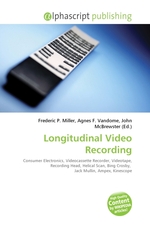Longitudinal Video Recording
Frederic P. Miller, Agnes F. Vandome, John McBrewster
бумажная книга
Please note that the content of this book primarily consists of articles available from Wikipedia or other free sources online. Longitudinal Video Recording or LVR was a consumer VCR system and videotape standard. Work had begun on longitudinal video recording as early as 1950 by the electronics division of entertainer Bing Crosby's production company, Bing Crosby Enterprises (BCE), who had pioneered the use of magnetic tape recording for his radio show in the 1940s. BCE gave the world's first demonstration of a videotape recording in Los Angeles on November 11, 1951. Developed by John T. Mullin and Wayne R. Johnson since 1950, the device gave what were described as "blurred and indistinct" images, using a modified Ampex 200 tape recorder and standard quarter-inch (0.6 cm) audio tape moving at 360 inches (9.1 m) per second. A year later, an improved version, using one-inch (2.6 cm) magnetic tape, was shown to the press, who reportedly expressed amazement at the quality of the images, although they had a "persistent grainy quality that looked like a worn motion picture".
Данное издание не является оригинальным. Книга печатается по технологии принт-он-деманд после получения заказа.


